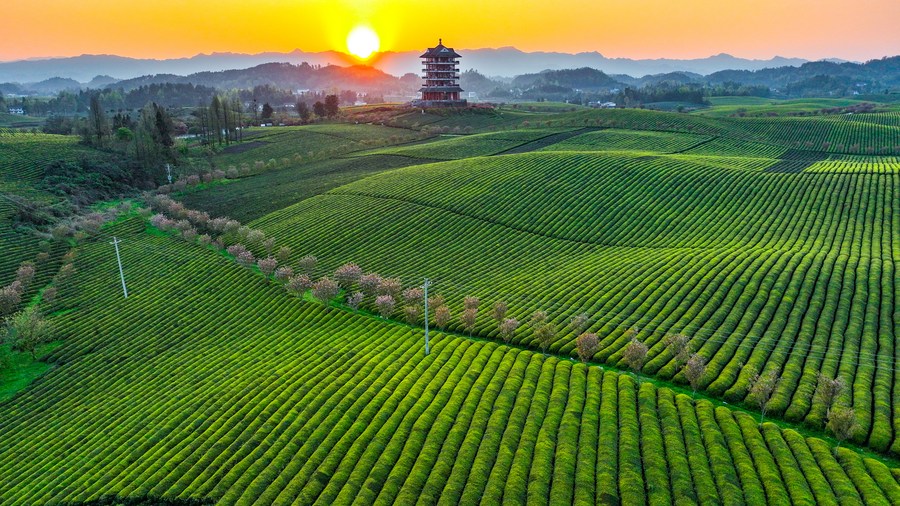

In the scorching summer, the mountain tea gardens of Qiannan Buyi and Miao Autonomous Prefecture, southwest China's Guizhou Province are a sea of vibrant green. Tea farmers bend over their work, their hands moving swiftly, quickly filling baskets with fresh, tender leaves that emit a pleasant fragrance. These small green leaves are the pillars of an industry that is becoming a cash cow for farmers in the region.
At present, all 12 counties and cities in the prefecture produce tea leaves. The prefecture's tea gardens cover an area of nearly 1.62 million mu (108,000 hectares), and the annual output value generated by these tea gardens has exceeded 10 billion yuan ($1.4 billion). More than 426,600 people work in prefecture's tea industry, with the average annual income reaching 17,500 yuan.
In recent years, Qiannan has developed its tea industry according to local conditions, integrating tea culture, industry, and technology, leading to a path of green development that benefits both the environment and the economy.

This aerial photo shows tea plantations in Yongxing Town, Meitan County, southwest China's Guizhou Province, April 4, 2023. (Xinhua/Ou Dongqu)
Standardization and branding
In February this year, an economic cooperative was established in Duyun city's Maojian town, which is known for Maojian green tea, to standardize tea garden management and harvesting. Currently the cooperative has over 60 tea workers managing 3,900 mu of tea gardens.
"I can earn 180 yuan a day near home. It's a stable job, so villagers rush to do it," said Tang Xiangang, a member of the cooperative.
In recent years, the prefecture has focused on the high-quality development of the tea industry, cultivating local premium tea companies and collaborating with well-known tea companies from other regions.
Qiannan has issued seven prefectural-level standards for tea garden management, tea picking, and tea processing, said Zheng Song, director of the tea industry development center of Qiannan prefecture.
Currently, the prefecture has established 20 efficient demonstration tea gardens, driving the construction of 220,000-mu of high-standard tea gardens, and the upgrading of over 191,100 mu of tea gardens. The standardization, branding, and large-scale development of the region's tea industry have significantly improved.
Scientific research and technical support
Fresh tea leaves are placed in a hot wok, crackling loudly, as the leaves collide with the high temperature of the pan. Hands quickly scoop up the leaves and sprinkle them evenly, repeating the process for five minutes until the fresh green color fades. Chen Ziyuan begins to knead the tea leaves intently, and with rhythmic changes in pressure, the leaves form a hook-like shape.
Chen Ziyuan, a provincial-level inheritor of the techniques involved in producing Duyun Maojian tea, a national intangible cultural heritage, provides technical guidance on planting, picking, and processing tea for local farmers. He also showcases ancient tea-making techniques while promoting tea culture to a wider audience through short-video platforms.
Unique climate conditions and an excellent ecological environment have made Qiannan prefecture an ideal area for producing high-quality tea, fostering a unique tea culture.
In Baijin town of Huishui county, there's a group of ancient tea trees, including one wild tree over 800 years old, embodying the profound cultural heritage of Qiannan's tea industry, said Zhang Lijuan, head of the tea research institute at the Qiannan Academy of Agricultural Sciences.
Zhang, also a senior agronomist, added that the region has actively cultivated tea varieties with local characteristics based on the germplasm resources of indigenous tea trees, with three new varieties already developed.
With the help of new technologies and research, the growth of the prefecture's tea industry has been accelerated. In 2022 alone, the academy collaborated with seven local enterprises to establish 26,000 mu of demonstration tea gardens. The application of new technologies increased the per mu yield of tea gardens from 89.43 kilograms in 2019 to 140.64 kilograms, generating an additional 43.98 million yuan in output value for the seven enterprises.
Integration of ecology and tourism
In recent years, Qiannan prefecture has promoted the construction of ecological tea gardens, laying a solid foundation for diverse development opportunities.
Pan Jianhui, director of Qiannan prefecture's bureau of agriculture and rural affairs, said the prefecture has established 382,600 mu of tea gardens that implement green pest control and disease prevention in an integrated manner. In addition, the prefecture has constructed 52,200 mu of organic tea gardens.
From growing tea to selling scenery, from selling tea to creating spaces, from talking about tea to promoting culture, relying on a good ecological environment and a rich cultural heritage, Qiannan prefecture has found a new direction for the industrialization of tourism.
To promote the integration of tea and tourism, Qiannan prefecture has formulated a work plan to promote the integrated development of tea, culture, and tourism. They have planned and launched six tea tourism premium routes.
"We have nurtured new business forms that blend tea with tourism and culture and built several new tourism routes by tapping into Maojian tea culture, achieving both ecological and economic benefits," said Guo Zhengyong, deputy secretary of the leading Party members group of Qiannan prefecture’s bureau of culture, radio, television and tourism.
点击右上角![]() 微信好友
微信好友
 朋友圈
朋友圈

请使用浏览器分享功能进行分享
